Silenced Women of the Bible
An Exhibition of Art by Jen Ford
Introduction to the Exhibition
Misogyny and sexism have played a great part in the way that we read the Bible and teach others from it, and as a result, women have suffered greatly and often in silence.
Domestic violence, bullying, spiritual, physical, and emotional abuse, continue to happen to women within church communities and very often the Bible is used to keep them silent and oppressed.
This series of paintings aims to change the way in which the church views women, by re-introducing those women in the Bible who have been wrongly shamed, blamed and accused, providing the same freedom, vindication, options and purpose to all.
Anna
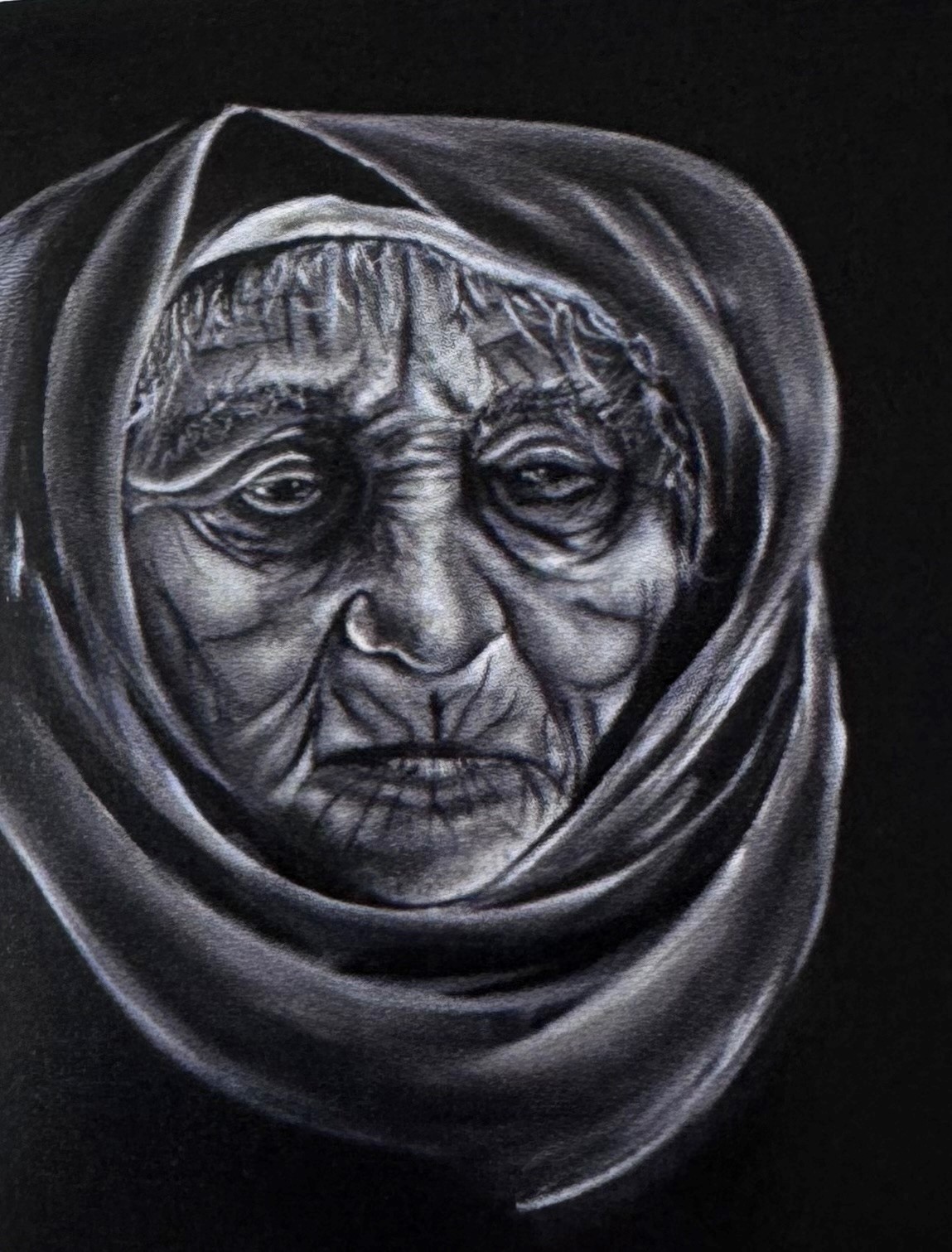 Why have you painted Anna as Sad?
Why have you painted Anna as Sad?
I imagined Anna to have lived through a significant amount of sadness. As an 84-year-old woman, she had lived most of her life alone. She was widowed only 7 years into her marriage and Luke 2v37 tells us that since then she never left the temple. Through all those long years Anna devoted herself to God and kicked back against the customs of the day in never re-marrying but turning to prayer in her pain.
Why do you think that Anna’s Story is overlooked?
I think we pay little attention to Anna for a few reasons. The first one being, she is only mentioned in a few short verses. Then there is the fact that we don’t hear from her directly in the text. Luke 2v38 tells us clearly that Anna prophesied about Jesus as a baby and spoke to all of those who were looking forward to the redemption of Israel. Her words, however, are not recorded and this could be due to several factors. Anna was from one of the lost tribes of Israel, which would have made her a person of less importance in society. She was also a woman; not just a woman, but an old, childless widow, and in the patriarchal, honour-driven community she lived in, this would have made her practically invisible. Nevertheless, she was not invisible to God.
Jael
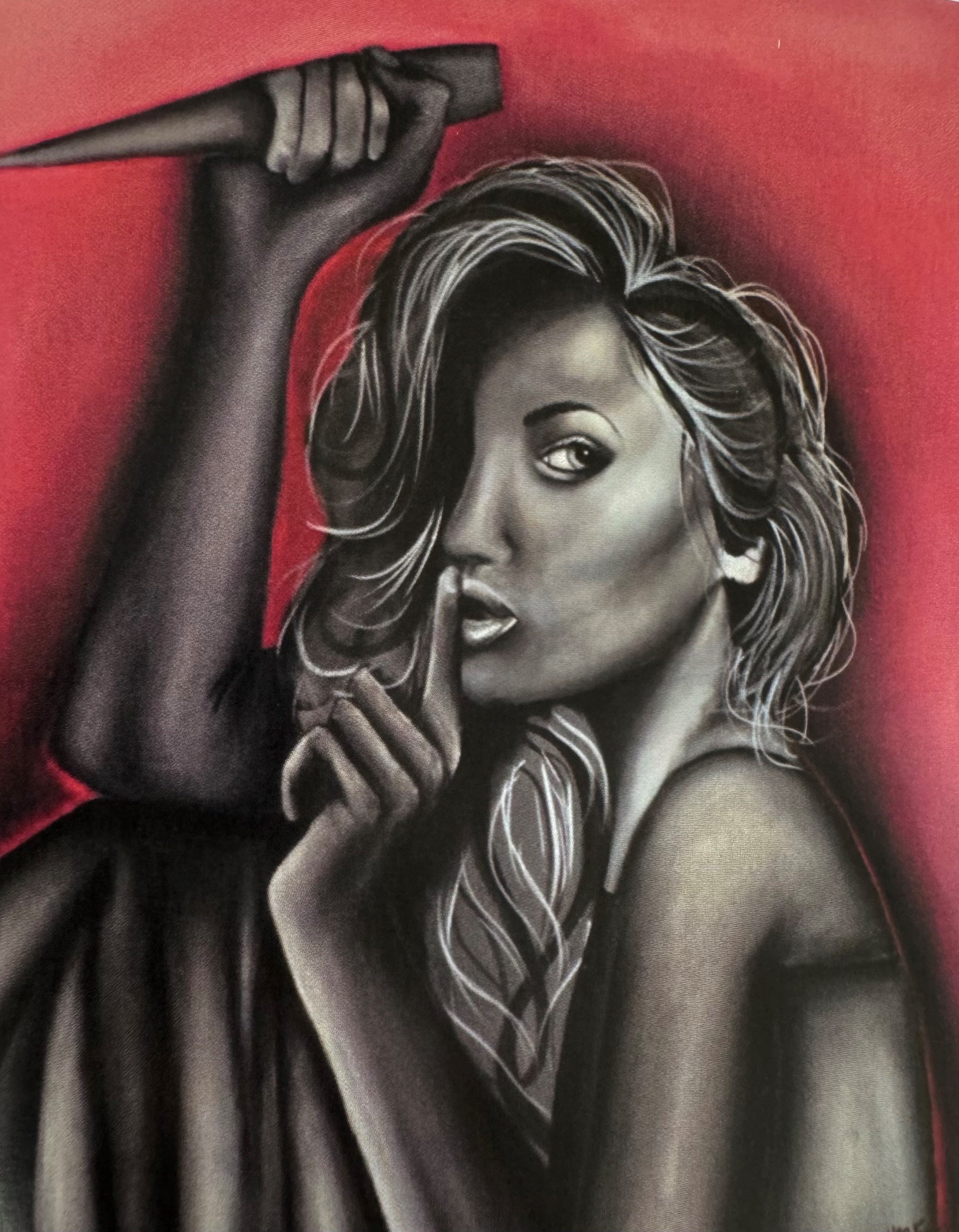 Why is this painting in colour?
Why is this painting in colour?
Two reasons: Jael is actually my favourite of all the women I have painted so far, and secondly, I wanted to somehow bring all the bloodthirsty, dark drama from this story to the foreground of the painting.
The picture suggests a calculated Assassin. Is that what you intended?
The short answer is YES! I am unable to read this story and draw any other conclusion. This is essentially a tale of man's cowardice and women getting the job done. In Judges 4 we read that Barak the warrior would not follow God's orders and attack Sisera's army without the physical backing of Deborah the prophetess. Because of his fear, Deborah prophesied that Sisera would indeed be delivered into the hands of a woman, not Barak. Whether Jael was inspired by God to murder Sisera, or just saw an opportunity and took matters into her own hands, I cannot help but see this as a deliberate act rather than defensive or accidental.
Why Paint her Pre-murder?
I made the decision to do this because this is the juiciest part of Jael's journey. There is something strangely alluring and slightly psychotic about a woman who calls a man into her tent promising him protection, 'Come in my lord... Don’t be afraid,' calmly tucks him up in bed to rest from his exhausting battle, then quietly dispatches him! This wasn’t just any murder either, she took a tent peg, drove it through his head and fastened him to the ground. He ran away from his dying army; he won't run away again! What strength of both arm and stomach she would have needed. Jael was one extraordinary woman.
Eve
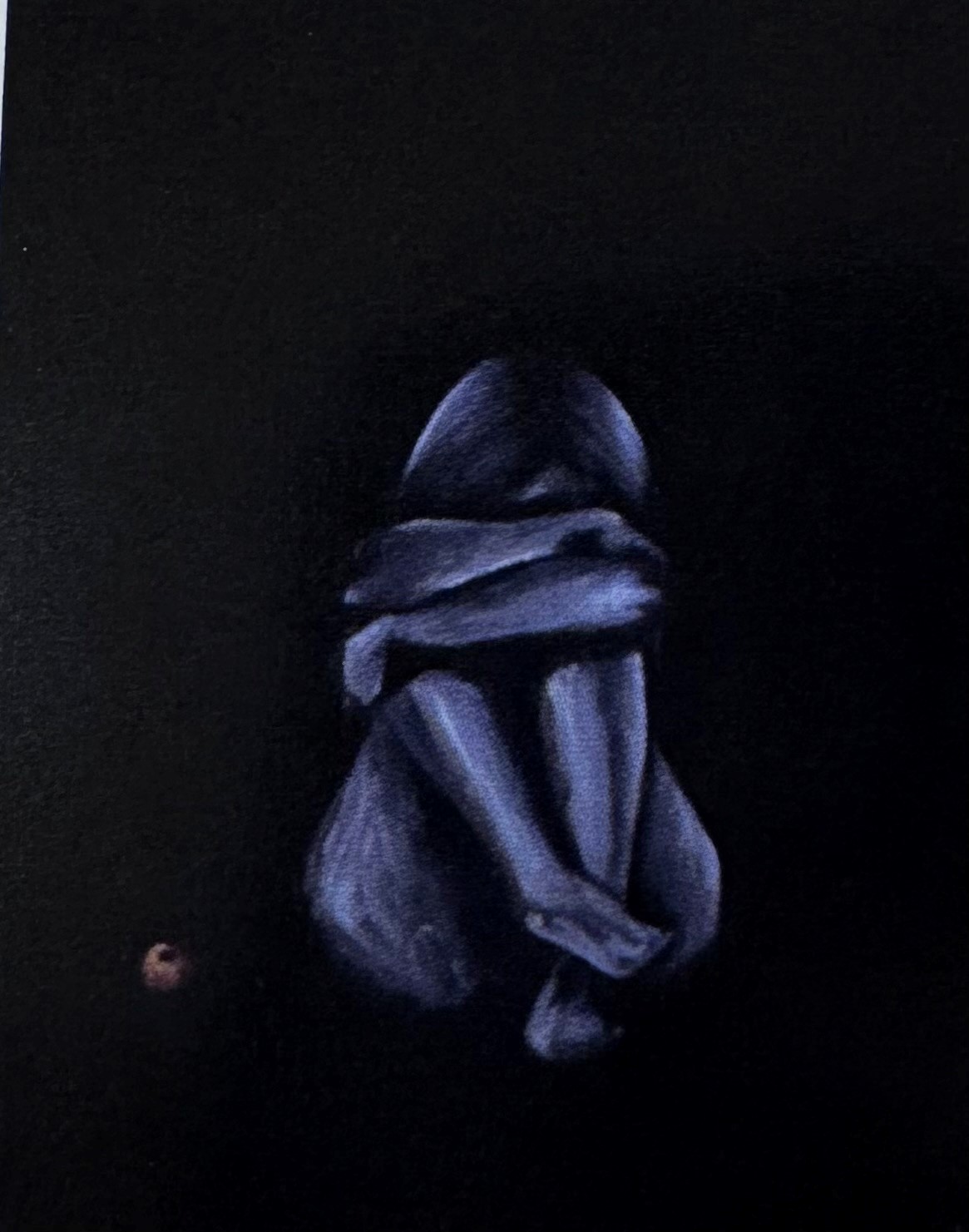 Why is Eve hiding her face?
Why is Eve hiding her face?
Whilst painting Eve, I pictured her as representing the whole of womankind. I painted her small and invisible to show how the character of Eve and her story has been mishandled. She has been wrongly used throughout history to reduce women, make them inferior and substandard.
I particularly wanted to portray the damage done to women through generations of misuse of The Fall narrative. This is the soul of woman, hiding.
Why is the apple whole?
There was a reluctance on my part to lay sole responsibility for the apple at the feet of Eve. Painting the apple bitten, I felt would continue the damaging rhetoric that Eve somehow opened Pandora's Box alone and ultimately stained the whole of womankind forever, plunging humanity into an abyss of mortality and imperfection. The reality is, Genesis 3 reads as another example of the reluctance of men/Adam to take any responsibility. Adam, a passive, dormant, seemingly mute bystander was with Eve during the whole of her exchange with the serpent and at no point did he pipe up with any admonishment or wisdom. He also partook of the fruit. If Adam was the spiritual head, the bridge between God and woman, the overseer, ordained by God to be in charge... he turned out to be pretty terrible at it! I would argue, that if we were to read Genesis 3 through a patriarchal lens, Adam's failing, was in fact much bigger! Accepting both were culpable, we are still left with the inescapable fact that Adam/man tried to shirk accountability in his attempt to blame God, and then also the woman. I guess in that respect, old habits die hard.
Bathsheba
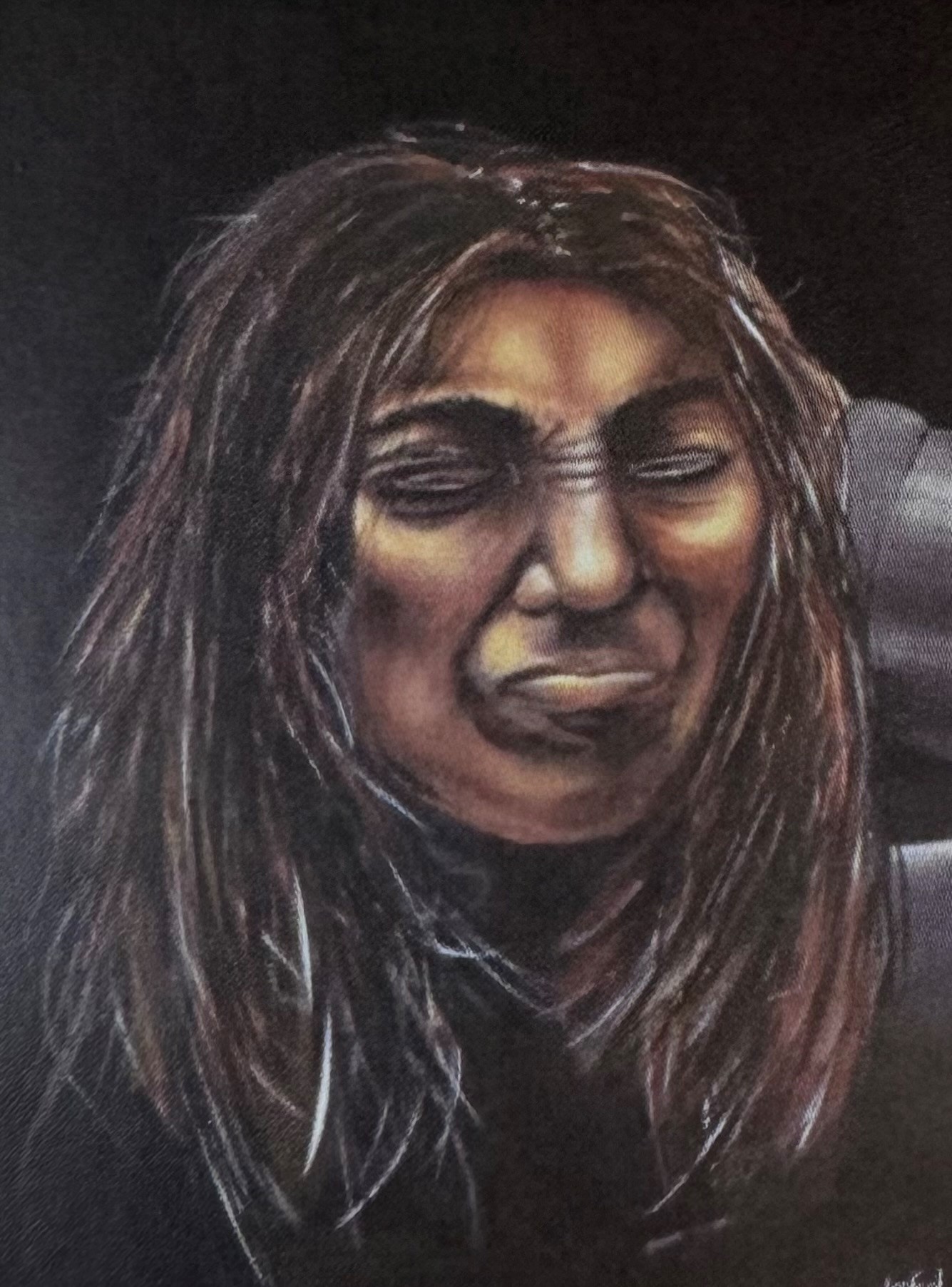 What impact do you think this story has had on attitudes towards women from a religious point of view?
What impact do you think this story has had on attitudes towards women from a religious point of view?
I personally feel this story, being such a popular one, has been taught wrongly so many times to so many people and therefore has had a tremendous impact. One of the first major problems being that because David is such a Biblical hero, God himself calling David a man after His own heart, we have justified most of his actions, believing them to be Godly. Through this painting I wanted to draw attention to the fact that in Bathsheba's story, David's actions cannot be justified. This story shows David to be an arrogant, murderous, womanizing rapist. The fact that God saw fit to look past all these crimes and love David like the Bible tells us, is all about how great and awesome the nature of God is and nothing to do with David himself.
Do you think that Bathsheba was broken?
In short, yes! Bathsheba was dragged from her home by the king’s men, and resisting a King would have had terrible consequences, one...
The Syrophoenician’s Daughter
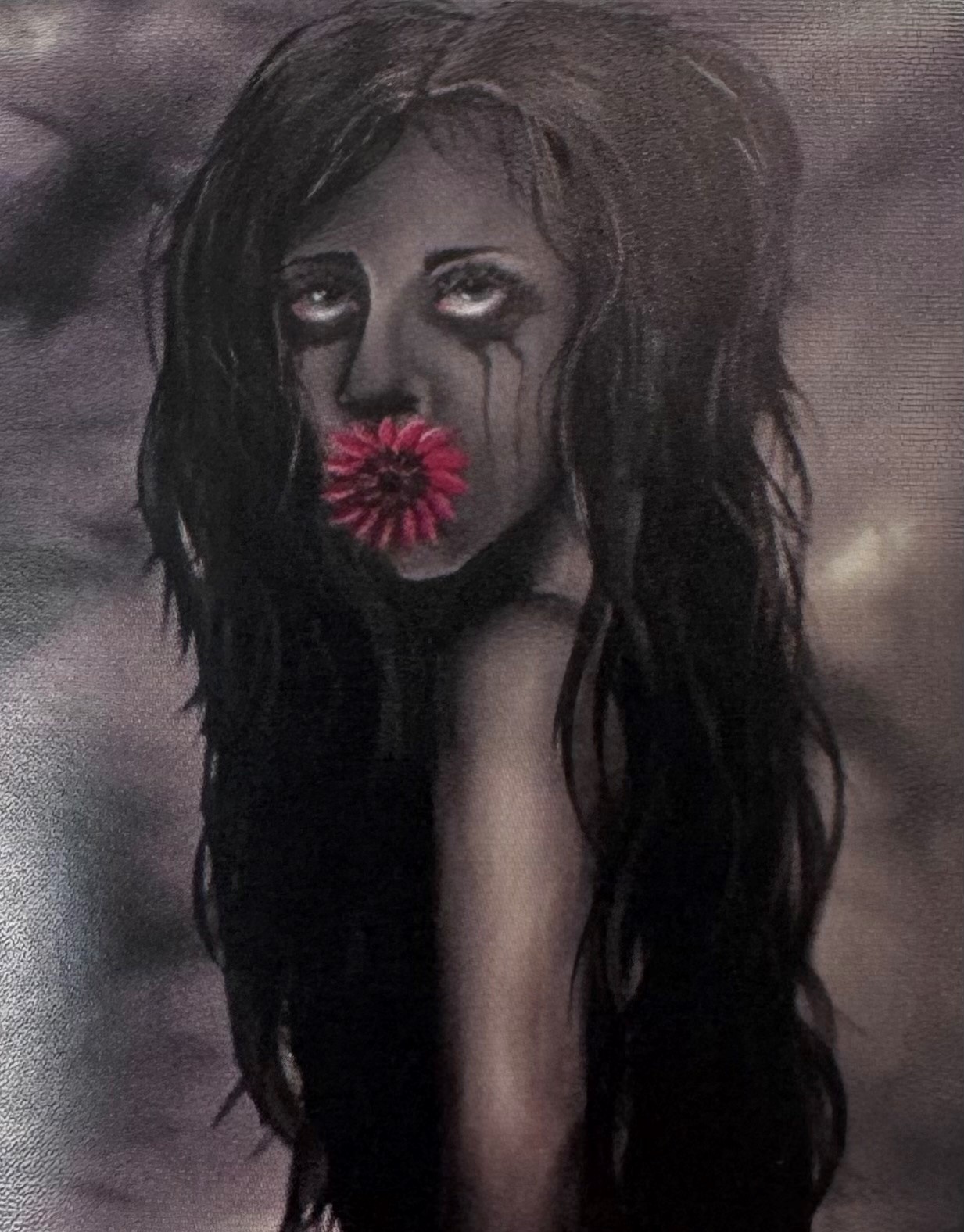 What does the flower signify?
What does the flower signify?
The flower in this painting is this girl’s healing. We read in Mark 7: 24-30, that Jesus healed her from her demon possession. When I read about demon possession in the Bible, I cannot help but wonder how much of their possession was misunderstood mental health issues. For this reason, I imagined her healing to be a healing of her inner voice; a healing of her mind.
The flower signifies her thoughts moving from chaos and despair to something healthy and blossoming and full of promise.
We don’t even meet this girl in the story, why did you choose to paint such a vague character?
I am moved by this story for a couple of reasons. Firstly, the desperate plea of a mother who has run out of options. Jesus was her last-ditch attempt to get her daughter back. That relationship is so palpable and one any mother can relate to. She was willing to buck all societal norms by approaching a Jewish rabbi for help when she herself was not part of God’s people, and not only that she argued with him when she herself was an uneducated woman, all for the sake of her child.
Secondly, I love the way that Jesus sees this woman’s spiritual intelligence and exposes it to the men she is surrounded by. She had grasped something about the gospel that none of the men around her had. She knew that the good news of Jesus Christ was for all.
The Woman with the Issue of Blood
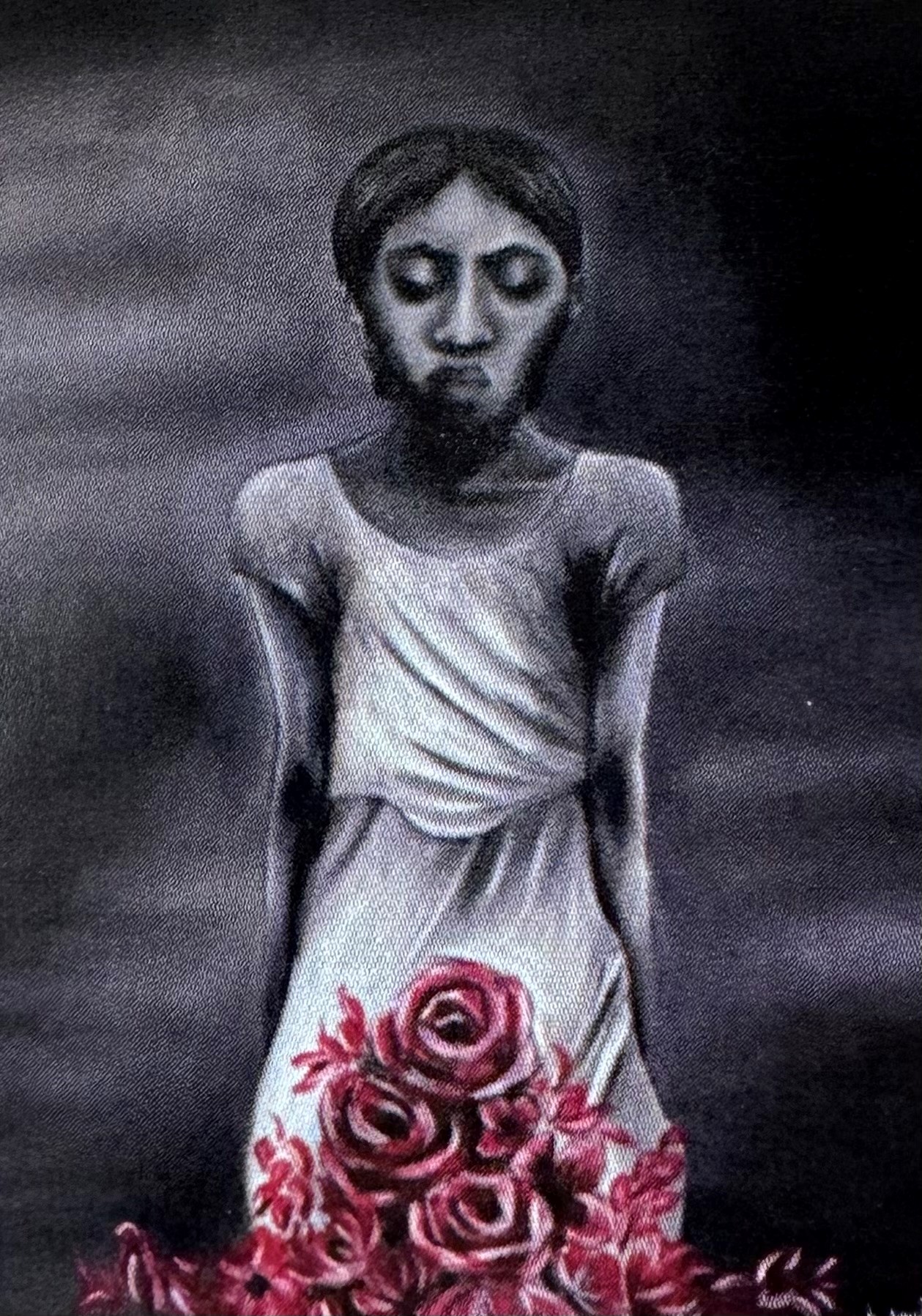 What made you paint the blood as flowers?
What made you paint the blood as flowers?
Her blood was the thing that made this woman an outcast. In this story, this woman’s blood meant she had to remove herself from the community. She was unclean. This meant she couldn’t worship in the temple, she couldn’t be touched by a man, she couldn’t partake in normal relationships. She would have been actively avoided. A forgotten woman, isolated and alone. Despite living under a cloud of shame, this woman was full of remarkable resilience and faith. She heard Jesus was nearby and flew in the face of the customs of the day, by going out amongst the crowds with her shame on show and she touched Jesus. She touched a man! On seeing Jesus, she was not afraid, and He healed her! Not only that, but in all the jostling crowds, with people bumping into Jesus left right and centre, Jesus made a point of noticing this woman. He spoke to her and called her ‘daughter’. After 12 years of period shaming, Jesus told that crowd in no uncertain terms that she was whole, beautiful and no longer to be avoided. The flowers represent that once again her bleeding became an outward symbol of the empowering, miraculous capacity of a woman’s body.
Hagar
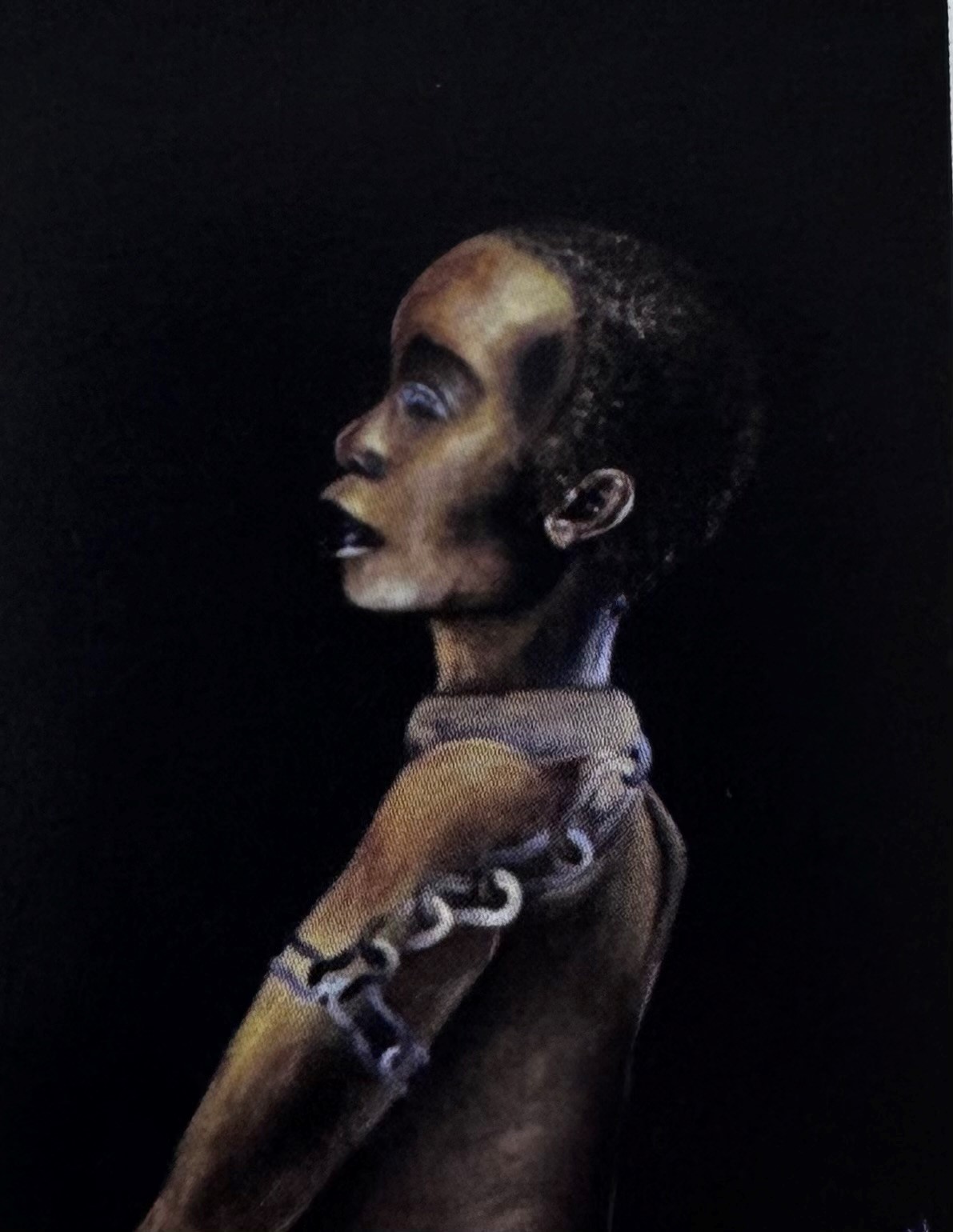 Why have you portrayed Hagar as a slave?
Why have you portrayed Hagar as a slave?
Hagar was owned by Abraham. The Bible is quite explicit, Gen 16:3-4 says, ‘Sarai took Hagar the Egyptian, her maid girl and gave her to Abraham as a wife.’ I think we can all agree that an unpaid worker with no choice and no rights is in fact a slave. Not only is she a slave, she is a passive object when handed to Abraham as a wife. She has no voice here. There is no consent. Sarai wills it, so it happens. Hagar is forced into a sexual relationship with a man without her consent. The chains in the painting are very real, whether physical or metaphorical, as they depict her in her complete oppression.
Was Hagar Black?
Well Genesis tells us that Hagar is from Egypt. The truth is that outside of that we have no way of knowing what Hagar’s genetic makeup is, but I imagined her as a woman of colour because her plight is reminiscent of the harrowing exploitation which black people have endured and still continue to endure through racism and white privilege all over the world.
The Woman Caught in Adultery
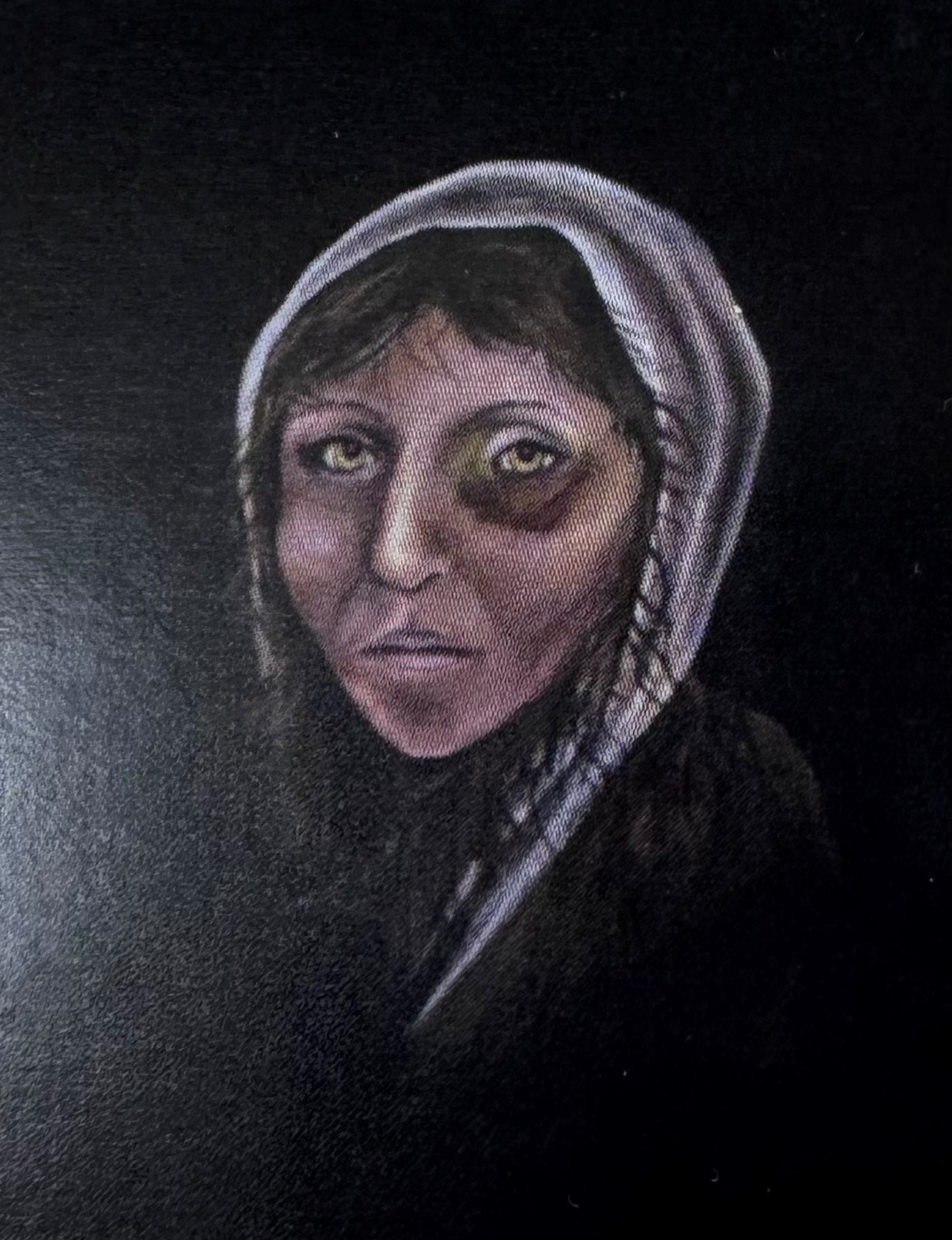 Was it deliberate to depict her as more homely?
Was it deliberate to depict her as more homely?
I wanted to show this woman as completely normal in every way. My aim was to detract from anything that may cause anyone to judge her actions. I think this is important because I don’t believe that that this woman, as important as she is, was the main point of this story. I believe the attitudes of the men are the real focal point.
I think that Jesus was driving home a real feminist message here, that the men involved were holding themselves to a different standard of judgment and behaviour than their female counterparts. She is painted as ordinary, because she was - just another woman with a broken relationship, yet they were prepared to kill her for it, without the man involved accepting any responsibility at all. Hypocrisy at its best!
There is a quiet defiance in her expression, would she have felt justified by Jesus’ actions?
I don’t know about whether she would have felt justified, but most certainly vindicated. John 8v11 tells us that Jesus told the woman, ‘…Then neither do I condemn you. Go and sin no more’. She may have been condemned by the men around her, but not by Jesus. He was not concerned with where she had been, but only where she was going. There is hope in her eyes because Jesus connected with her rather than her lifestyle.
Vashti
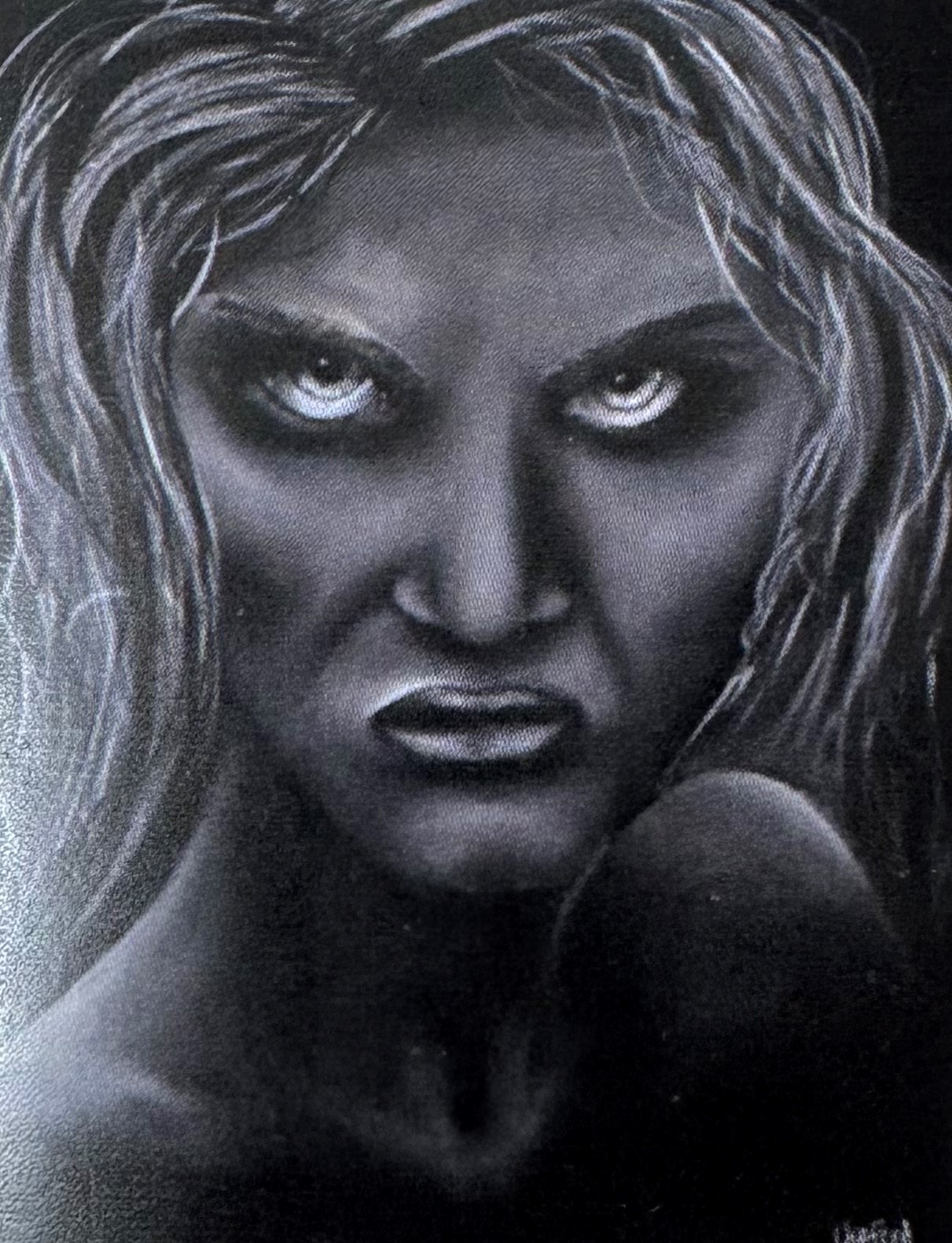 Is there a fine line between ‘angry’ and ‘evil’?
Is there a fine line between ‘angry’ and ‘evil’?
Vashti is most certainly angry in this picture, and rightly so. I think that there are lots of things in this world that should make us very angry, and in fact, not being angry about them allows evil to continue, for example, oppression, violence, racism, sexism, poverty, injustice, inequality, greed, entitlement, etc.
Do you think that women are branded as hysterical, where men are heroic?
Yes, I definitely think this is the case, both when these texts were recorded and still today. If a woman gets angry today, you will often find there are a raft of excuses for her anger; hormones, her period, the change, just being ‘a girl’, but very rarely will men look deeper and admit she has been treated abysmally. This is what happened to Vashti. She was asked by her drunken, tyrannical husband to dance provocatively before all his lecherous drunken friends, and when she angrily refused, she was expelled/cast out. She has been branded by men as proud and a terrible wife, as an example of a rebellious ungodly spouse. In truth, Vashti knew her worth enough to not let her failure of a husband define her and steal her dignity.
Tamar
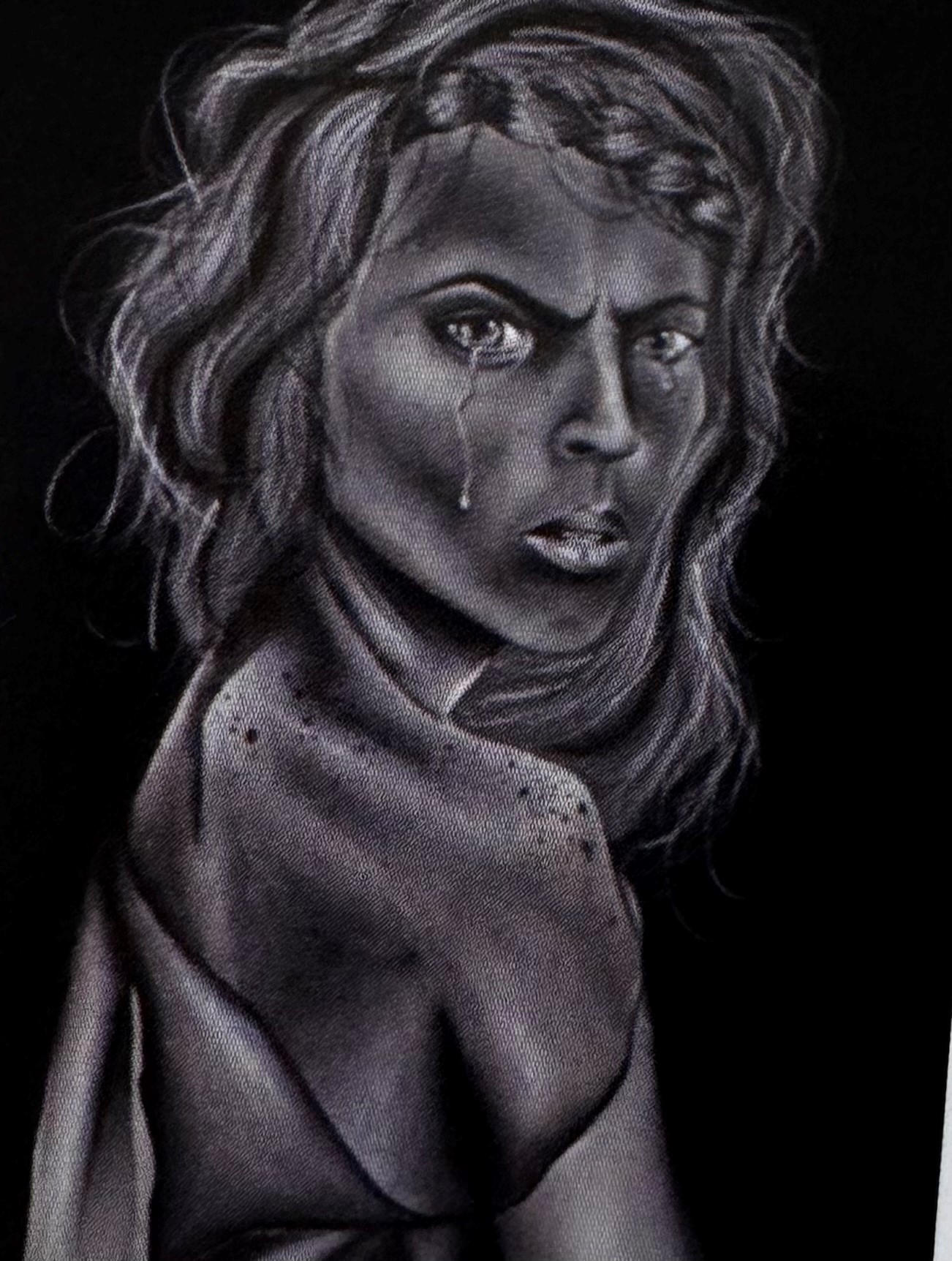 What expression did you most want to convey?
What expression did you most want to convey?
Total and unapologetic defiance. I read this story in 2 Samuel 13 and can’t help but be heartbroken on behalf of Tamar. So young and so trusting, she had her trust betrayed by a loved family member and was failed by a father who didn’t avenge her. We are told that she tore her clothes with grief. I wanted her torn clothes and her tears to be front and centre, her pain raw and tangible. Tamar in her fear pleaded for her safety, even desperately offering herself as a wife if he would not shame her, then we are told that Amnon hated her as much as he had previously loved her once he was done.
The entitlement of this man, treating a woman as a thing, taking her without consent and then casting her to one side with vehement disgust, is all in the expression on Tamar’s face here. Anger at the world, self-loathing and utter brokenness.
I think most women have at one point in their life or another been subject to maltreatment from a man in one way or another, whether that be through physical violence, verbal abuse, psychological abuse, or threatening behavior of any kind. All women are familiar with this level of defiance, as the unfortunate truth is that society is still struggling with its attitude towards women. Tamar’s defiance represents the defiance of all women in the face of persisting misogynistic outlooks in our communities.